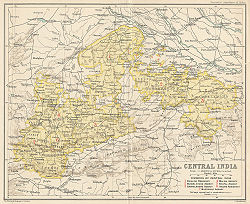Bundelkhand Agency
| Bundelkhand Agency | |||||
| Agency of British India | |||||
|
|||||
| Map of the Central India Agency with the Bundelkhand Agency in the eastern part | |||||
| History | |||||
| • | Established | 1811 | |||
| • | Independence of India | 1948 | |||
| Area | |||||
| • | 1901 | 25,510 km2(9,849 sq mi) | |||
| Population | |||||
| • | 1901 | 1,308,326 | |||
| Density | 51.3 /km2 (132.8 /sq mi) | ||||
The Bundelkhand Agency was a political agency of the British Raj, managing the relations of the British government with the protected princely states of the Bundelkhand region.
The Marathas ceded parts of Bundelkhand, which were later called later British Bundelkhand, to the British in the 1802 Treaty of Bassein. After 1802, many of the local rulers were granted sanads (leases) by the British, which entitled them to the lands they controlled at the death of Ali Bahadur, in return for the rulers signing a written bond of allegiance (ikrarnama) to the British. A political officer attached to the British forces in Bundelkhand supervised British relations with the sanad states. In 1806 British protection was promised to the Maratha ruler of Jhansi, and in 1817 the British recognized his hereditary rights to Jhansi state. In 1818 the Peshwa in Pune ceded all his rights over Bundelkhand to the British at the conclusion of the Third Anglo-Maratha War.
The sanad states were organized into the Bundelkhand Agency in 1811, when a political agent to the Governor-General of India was appointed and headquartered at Banda. In 1818 the headquarters were moved to Kalpi, in 1824 to Hamirpur, and in 1832 back to Banda. The political agent was placed under the authority of the Lieutenant-Governor of the North-Western Provinces, headquartered in Agra, in 1835. In 1849 authority over the Bundelkhand Agency was placed briefly under the Commissioner for the Saugor and Nerbudda Territories, who appointed a political assistant based at Jhansi. Shortly thereafter, authority over Bundelkhand was placed under the Resident at Gwalior, and the headquarters of the political assistant was moved to Nowgong, which remained until 1947. In 1853 the Raja of Jhansi died childless, and his territory was annexed to British Bundelkhand. The Jhansi State and the Jalaun and Chanderi districts were then formed into a superintendency. In 1854 Bundelkhand Agency was placed under the authority of the newly created Central India Agency, headquartered at Indore.
...
Wikipedia

